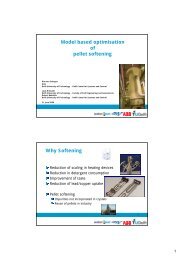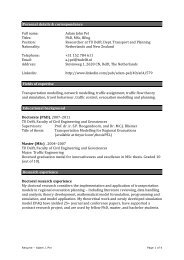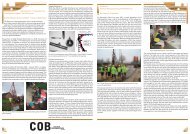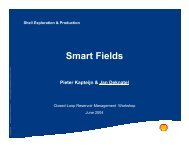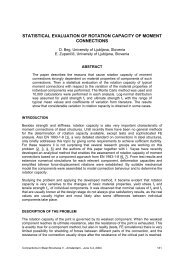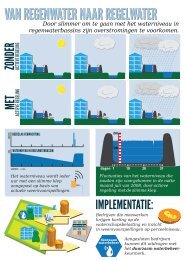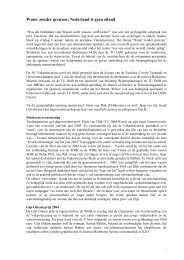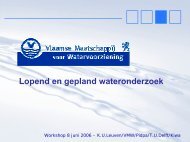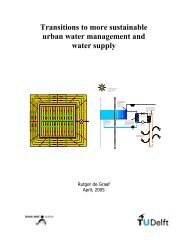Pedestrian route-choice and activity scheduling theory and models
Pedestrian route-choice and activity scheduling theory and models
Pedestrian route-choice and activity scheduling theory and models
Create successful ePaper yourself
Turn your PDF publications into a flip-book with our unique Google optimized e-Paper software.
S.P. Hoogendoorn, P.H.L. Bovy / Transportation Research Part B 38 (2004) 169–190 181<br />
Markov diffusion process in two dimensions with nearest-neighbor transitions that are determined<br />
by the stochastic differential Eq. (4) (Fleming <strong>and</strong> Soner, 1993). Solving this (discrete) stochastic<br />
dynamic programming problem is related to solving Eq. (24) by replacing the partial derivatives<br />
with the appropriate finite differences. Let u i denote the unit vector in the ith dimension (i ¼ 1; 2).<br />
The forward finite difference D þ x i<br />
W <strong>and</strong> backward finite difference D xi<br />
W are defined by<br />
D x i<br />
W :¼ d 1 ½W ðt; x du i Þ W ðt; xÞŠ for i ¼ 1; 2 ð31Þ<br />
For the second-order terms, we then use the following approximations<br />
D 2 x i<br />
W :¼ d 2 ½W ðt; x þ du i Þ 2W ðt; xÞþW ðt; x du i ÞŠ for i ¼ 1; 2<br />
D x i x j<br />
W :¼ 1 2 d 2 ½W ðt; x þ dðu i u j ÞÞ þ 2W ðt; xÞþW ðt; x dðu i u j Þ i<br />
ÞŠ ð32Þ<br />
1 2 d 2 ½W ðt; x þ du i ÞþW ðt; x þ du j ÞþW ðt; x du i ÞþW ðt; x du j ÞŠ<br />
In numerically approximating Eq. (24), the following solution approach is proposed (Fleming <strong>and</strong><br />
Soner, 1993):<br />
W ðt h; xÞ ¼W ðt; xÞ hHðx; D x i<br />
W ; D 2 x i<br />
W ; D x i x j<br />
W Þ ð33Þ<br />
where the numerical Hamiltonian is defined by<br />
(<br />
Hðx; D x i<br />
W ; D 2 x i<br />
W ; D x i x j<br />
W Þ¼ min Lðt; x; vÞ þ X<br />
v2V a ðt;xÞ<br />
i<br />
v þ i<br />
D þ x i<br />
W<br />
v i<br />
D xi<br />
W <br />
þ 1 X<br />
H ii ðx; vÞD 2 x<br />
2<br />
i<br />
W þ 1 X<br />
ðH þ ij<br />
2<br />
ðx; vÞDþ x i x j<br />
W<br />
i<br />
i<br />
H ij<br />
ðx; vÞD xi x j<br />
W Þ<br />
ð34Þ<br />
where a þ :¼ maxfa; 0g <strong>and</strong> a :¼ minfa; 0g. This numerical solution approach has been adopted<br />
in the dedicated microscopic pedestrian flow simulation model NOMAD (Hoogendoorn, 2001).<br />
Example 1 (Route <strong>choice</strong> <strong>and</strong> <strong>activity</strong> area <strong>choice</strong> for free-flow conditions in Schiphol Plaza). This<br />
example considers Schiphol Plaza, which is a multi-purpose multi-modal transfer station. Fig. 1<br />
shows a snapshot of the microscopic simulation model NOMAD described in (Hoogendoorn,<br />
2001). In this figure, exits E1–E5 indicate exits from Schiphol Plaza; escalators E6 <strong>and</strong> E7 indicate<br />
exits to the train platforms. V1 <strong>and</strong> V2 depict the locations of the newspaper vendors. The colors<br />
reflect pedestrians having distinct <strong>activity</strong> schedules; the color intensity reflects gender (light: female,<br />
dark: male).<br />
Fig. 2a <strong>and</strong> b respectively show the expected minimum perceived disutility functions W <strong>and</strong><br />
example <strong>route</strong>s for pedestrians using the escalators E6 or E7 to get to the train platform <strong>and</strong><br />
pedestrians using either of the exits E1–E5 to get outside. The expected minimum perceived<br />
disutility functions have been determined using the numerical solution approach described in<br />
Section 5.5.3, with <strong>route</strong> weights c 1 ¼ 1, c 2 ¼ 10, c 3 ¼ 1:5, c 4 ¼ c 5 ¼ 0, <strong>and</strong> a m ¼ 1 <strong>and</strong> b m ¼ 0:1<br />
(for all obstacles m). Eq. (29) shows that the optimal <strong>route</strong>s are perpendicular to the iso-expected<br />
minimum perceived disutility function curves depicted in the figures. Fig. 2a shows three exemplar<br />
)



